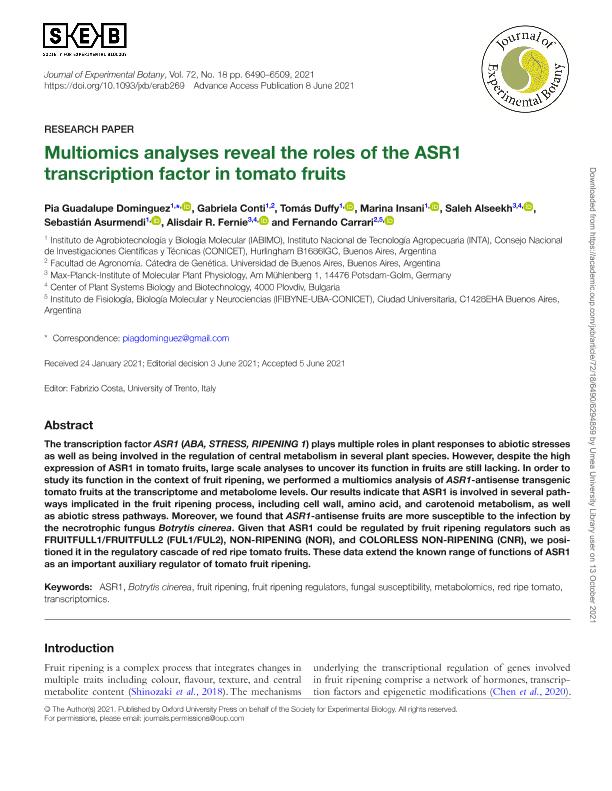Artículo
Multiomics analyses reveal the roles of the ASR1 transcription factor in tomato fruits
Dominguez, Pia Guadalupe ; Conti, Gabriela
; Conti, Gabriela ; Duffy, Tomás
; Duffy, Tomás ; Insani, Ester Marina; Alseekh, Saleh; Asurmendi, Sebastian
; Insani, Ester Marina; Alseekh, Saleh; Asurmendi, Sebastian ; Fernie, Alisdair R; Carrari, Fernando Oscar
; Fernie, Alisdair R; Carrari, Fernando Oscar
 ; Conti, Gabriela
; Conti, Gabriela ; Duffy, Tomás
; Duffy, Tomás ; Insani, Ester Marina; Alseekh, Saleh; Asurmendi, Sebastian
; Insani, Ester Marina; Alseekh, Saleh; Asurmendi, Sebastian ; Fernie, Alisdair R; Carrari, Fernando Oscar
; Fernie, Alisdair R; Carrari, Fernando Oscar
Fecha de publicación:
09/2021
Editorial:
Oxford University Press
Revista:
Journal of Experimental Botany
ISSN:
0022-0957
Idioma:
Inglés
Tipo de recurso:
Artículo publicado
Clasificación temática:
Resumen
The transcription factor ASR1 (ABA, STRESS, RIPENING 1) plays multiple roles in plant responses to abiotic stresses as well as being involved in the regulation of central metabolism in several plant species. However, despite the high expression of ASR1 in tomato fruits, large scale analyses to uncover its function in fruits are still lacking. In order to study its function in the context of fruit ripening, we performed a multiomics analysis of ASR1-antisense transgenic tomato fruits at the transcriptome and metabolome levels. Our results indicate that ASR1 is involved in several pathways implicated in the fruit ripening process, including cell wall, amino acid, and carotenoid metabolism, as well as abiotic stress pathways. Moreover, we found that ASR1-antisense fruits are more susceptible to the infection by the necrotrophic fungus Botrytis cinerea. Given that ASR1 could be regulated by fruit ripening regulators such as FRUITFULL1/FRUITFULL2 (FUL1/FUL2), NON-RIPENING (NOR), and COLORLESS NON-RIPENING (CNR), we positioned it in the regulatory cascade of red ripe tomato fruits. These data extend the known range of functions of ASR1 as an important auxiliary regulator of tomato fruit ripening.
Archivos asociados
Licencia
Identificadores
Colecciones
Articulos (IABIMO)
Articulos de INSTITUTO DE AGROBIOTECNOLOGIA Y BIOLOGIA MOLECULAR
Articulos de INSTITUTO DE AGROBIOTECNOLOGIA Y BIOLOGIA MOLECULAR
Citación
Dominguez, Pia Guadalupe; Conti, Gabriela; Duffy, Tomás; Insani, Ester Marina; Alseekh, Saleh; et al.; Multiomics analyses reveal the roles of the ASR1 transcription factor in tomato fruits; Oxford University Press; Journal of Experimental Botany; 72; 18; 9-2021; 6490-6509
Compartir
Altmétricas



